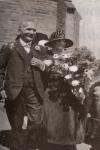
Cornelis Jacobus Langenhoven
Born in August 13, 1873 / Died in July 15, 1932 / South Africa / English
Biography
Cornelis Jacobus Langenhoven, wrote under the pen name C.J. Langenhoven and was better known as Sagmoedige Neelsie (Gentle Neelsie) or Kerneels. He had a formidable role in South Africa's Afrikaans literature and cultural history, and was one of the young language's foremost promoters. He is best known to have written the words for the original South African Anthem Die Stem. Langenhoven was born at Hoeko, Ladismith, Cape Colony and later moved to Oudtshoorn where he became its most famous resident. In 1897 he married the widow Lenie van Velden. They had one child, a daughter named Engela, who was born in 1901. By 1914 he became a member of parliament (first as member of The House of Assembly, and later as Senator) where he took the struggle to have Afrikaans officially recognised, to the next level. He was also a founder member of the new Afrikaans newspaper Die Burger, and a Freemason. C.J. Langenhoven's most famous work is the original South African Anthem Die Stem which he wrote in 1918. To celebrate the centenary of his birth, the South African Post Office issued a four-cent C.J. Langenhoven stamp in 1973.
Work
C.J. Langenhoven's most famous work is the original South African Anthem Die Stem (i.e., "The Voice / The Call of South Africa") which he wrote in 1918. Parts of this anthem have been worked into the new national anthem since apartheid was abolished. Aside from this, his writing career spanned almost every genre, from poetry to ghost and alien stories. Langenhoven also translated several works into Afrikaans, amongst these was the Rubaiyat of Omar KhayyamOmar Khayyam. He created new Afrikaans proverbs and even wrote a love poem (albeit in nonsense verse) to his dog. Langenhoven was instrumental in the movement for the acceptance of Afrikaans as a language, in general and as the first language in schools, instead of Dutch. This culminated in the language officially being used in parliament in 1925, and by 1927 was recognised as an official language of South Africa, together with English.
Personality
One of the most versatile writers in Afrikaans, he was a master of the short form of prose and is best remembered for his humorous and satirical works. Langenhoven was well known for his sharp wit and gentle manner. He owned an imaginary elephant named Herrie ("Harry") that appeared in many of his stories. He even carved its name onto a boulder next to the N12 highway near Meiringspoort (outside Oudtshoorn) in 1929. This boulder known as Herrie's Stone ("Herrie se Klip", in Afrikaans), has been declared a South African national monument.
Legacy
The Stellenbosch University Student Center is named after him and is affectionately known as "Die Neelsie" ("The Neelsie"). South African filmmaker Manie van Rensburg made a light-hearted comedic television series based on Langenhoven's work in 1983, titled Sagmoedige Neelsie. To celebrate the centenary of his birth, the South African Post Office issued a 4 cent C.J. Langenhoven stamp in 1973. Langenhoven is regarded as one of the most prolific and most versatile Afrikaans writers still today, his Collected Works comprising 16 volumes. He is also fondly remembered and referred to for his quirky personality. The place he and his family lived in, called the Arbeidsgenot, (meaning "the pleasure of work" or "the joy of labour") has been turned into a house museum. They lived there from 1901 until 1950. ..





